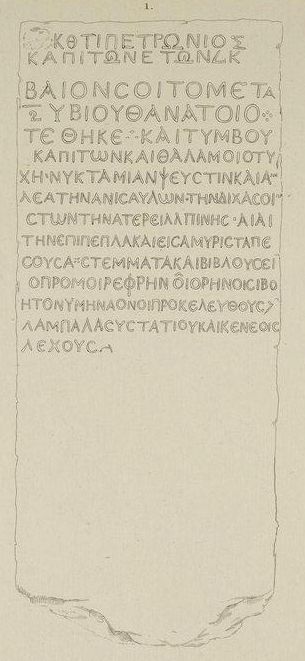Support: Stele of unknown stone broken away below
(dimensions unknown).
Layout: Inscribed on front face in 15 lines.
Letters: Unknown height; three styles of script: a) at ll. 1-2, capitals: alpha with straight bar, four strokes non-slanting sigma,
omega with developed lower part; b) at ll. 3-5, larger characters than a): alpha with dropped bar, alpha and lambda with projecting
right stroke, lunate epsilon and sigma, xi with serpentine central part; c) l. 6 on: same shapes as b) (also lunate omega),
smaller in size than a). Separators with various design for an often ill-placed punctuation.
Date: Probably 198/9 AD (internal date, lettering).
Findspot: First copied by J.-R. Pacho in 1825 at
Cyrene ➚:
presumably in one Necropolis.
Place of origin: Findspot.
Last recorded location:
Copied by J.-R. Pacho in 1825 in Shahat.
Neither seen by GVCyr team nor by J.M. Reynolds for IRCyr, it seems to be lost.
Text constituted from: Transcription from editor.
French translation
[L'an 2]29, Tiberios Petrônios Kapitôn, (scil. mort) à l'âge de 24 ans.
La Fortune a mis pour toi un espace bref
entre la vie et la mort et entre le tombeau et la chambre nuptiale, Kapitôn,
elle a mis une seule nuit, mensongère et impitoyable, une nuit sans flûtes,
une nuit pour toi privée de voiles nuptiaux, une nuit dépourvue de festin ;
hélas, ta cendre tombant sur tes vêtements, sur tes couronnes
non encore parfumées, sur tes livres, mort que tu es avant l'heure !
Ah, Hyménée célébré par des thrènes ! Ah, les flambeaux
qui t'ont escorté vers cette couche ultime et vide !
English translation
[Year 2]29, Tiberios Petronios Kapiton, (scil. died) aged 24 years.
Fortune set for you a short space
between life and death and between the tomb and the bridal-room, Kapiton,
she set one night, deceptive and pitiless, a night without flutes,
a night deprived for you of wedding curtains, a night lacking banquet;
alas, your ashes falling down onto your dress, onto your wreaths
not yet flavoured, onto your books, you dead before your time!
Ah Hymenaos celebrated with laments! Ah torches
leading you to this ultimate and empty couch!
Italian translation
[Anno 2]29, Tiberios Petronios Kapiton, di 24 anni.
La Sorte ha posto per te un intervallo breve
tra la vita e la morte, tra la tomba, Kapiton, e la stanza nuziale,
una sola notte, menzognera e impietosa, senza flauti,
lontana per te dalle cortine del talamo, senza banchetto;
ahimé cadono sulle tue vesti, sulle tue corone
non ancora profumate, sui tuoi libri le ceneri, tu morto anzitempo!
Oh Imeneo celebrato con lamenti! Oh, torce
che ti hanno scortato verso questo letto, estremo e vuoto!

